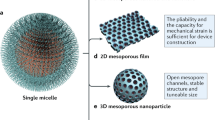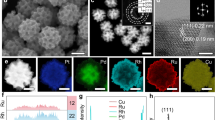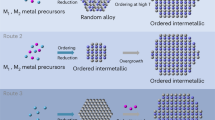Abstract
Although the chemical diversity of ordered composite mesoporous materials has been expanding during the past decade1,2,3,4,5,6,7,8,9,10,11,12,13, progress has been limited by the need for a general synthetic approach that is predictive and makes use of well developed fundamental chemical principles. Researchers have previously used the interaction of organic–inorganic (OI) species that are present during the nucleation of the composite phase, and several synthesis pathways, such as direct surfactant–inorganic interaction (S+I−, S−I+, S0I0) and mediated interaction (S+X−I+, S−X+I−), have been proposed2,3. Here we describe a new perspective in which the self-adjusted inorganic–inorganic (II) interplay between two or more inorganic precursors is guided by acid–base chemistry considerations, and in this simple way we produce an overall 'framework' for the sophisticated combination of synergic inorganic acid–base precursor pairs. We propose several new routes and demonstrate their versatility and validity through the successful syntheses of a wide variety of highly ordered, large-pore, homogeneous, stable and multicomponent mesostructured minerals, including metal phosphates and metal borates, as well as various metal oxides and mixed metal oxides. We show that the highly ordered mesostructured metal phosphates can be moulded into morphologies of choice, and that they show interesting physicochemical properties.
This is a preview of subscription content, access via your institution
Access options
Subscribe to this journal
Receive 12 print issues and online access
$259.00 per year
only $21.58 per issue
Buy this article
- Purchase on Springer Link
- Instant access to full article PDF
Prices may be subject to local taxes which are calculated during checkout




Similar content being viewed by others
References
Kresge, C.T., Leonowicz, M.E., Roth, W.J., Varuli, J.C. & Beck, J.S. Ordered mesoporous molecular sieves synthesized by a liquid-crystal template mechanism. Nature 359, 710–712 (1992).
Huo, Q. et al. Generalized synthesis of periodic surfactant/inorganic composite materials. Nature 368, 317–321 (1994).
Tanev, P.T. & Pinnavaia, T.J. A neutral templating route to mesoporous molecular-sieves. Science 267, 865–867 (1995).
Antonelli, D.M. & Ying, J.Y. Synthesis of a stable hexagonally packed mesoporous niobium oxide molecular sieve through a novel ligand-assisted templating mechanism. Angew. Chem. Int. Edn 35, 426–430 (1996).
Attard, G.S. et al. Mesoporous platinum films from lyotropic liquid crystalline phases. Science 278, 838–840 (1997).
Zhao, D. et al. Triblock copolymer syntheses of mesoporous silica with periodic 50 to 300 angstrom pores. Science 279, 548–552 (1998).
Yang, P., Zhao, D., Margolese, D.I., Chmelka, B.F. & Stucky, G.D. Generalized syntheses of large-pore mesoporous metal oxides with semicrystalline frameworks. Nature 396, 152–155 (1998).
Asefa, T., MacLachlan, M.J., Coombs. N. & Ozin, G.A. Periodic mesoporous organosilicas with organic groups inside the channel walls. Nature 402, 867–871 (1999).
Ryoo, R., Joo, S.H. & Jun, S. Synthesis of highly ordered carbon molecular sieves via template-mediated structural transformation. J. Phys. Chem. B 103, 7743–7746 (1999).
Inagaki, S., Guan, S., Ohsuna, T. & Terasaki, O. Mesoporous organic–silica hybrid with crystal-like pore walls. Nature 416, 304–307 (2002).
Schüth, F. Non-siliceous mesostructured and mesoporous materials. Chem. Mater. 13, 3184–3195 (2001).
Sakamoto, Y. et al. Direct imaging of the pores and cages of three-dimensional mesoporous materials. Nature 408, 449–453 (2000).
Stucky, G.D. et al. Directed synthesis of organic/inorganic composite structures. Stud. Surf. Sci. Catal. 105, 3–28 (1997).
Corriu, R.J.P. & Leclercq, D. Recent developments of molecular chemistry for sol–gel process. Angew. Chem. Int. Edn 35, 1420–1436 (1996).
Vioux, A. Nonhydrolytic sol–gel routes to oxides. Chem. Mater. 9, 2292–2299 (1997).
Tiemann, M. & Fröba, M. Mesostructured aluminophosphates synthesized with supramolecular structure directors. Chem. Mater. 13, 3211–3217 (2001).
Braun, P.V., Osenar, P., Tohver, V., Kennedy, S.B. & Stupp. S.I. Nanostructure templating in inorganic solids with organic lyotropic liquid crystals. J. Am. Chem. Soc. 121, 7302–7309 (1999).
Zhao, D., Luan, Z. & Kevan, L. Synthesis of thermally stable mesoporous hexagonal aluminophosphate molecular sieves. Chem. Commun. 1009–1010 (1997).
Bhaumik, A. & Inagaki, S. Mesoporous titanium phosphate molecular sieves with ion-exchange capacity. J. Am. Chem. Soc. 123, 691–696 (2001).
Serre, C., Magnier, C., Hervieu, M., Taulelle, F. & Férey, G. Synthesis and characterization of mesostructured titanium(IV) fluorophosphates with a semicrystalline inorganic framework. Chem. Mater. 14, 180–188 (2002).
Ciesla, U., Schacht, S., Stucky, G.D., Unger, K.K. & Schüth, F. Formation of a porous zirconium oxo phosphate with a high surface area by a surfactant-assisted synthesis. Angew. Chem. Int. Edn 35, 541–543 (1996).
Jiménez-Jiménez, J. et al. Surfactant-assisted synthesis of a mesoporous form of zirconium phosphate with acidic properties. Adv. Mater. 10, 812–815 (1998).
Doi, T. & Miyake, T. Synthesis of a novel mesoporous VPO compound. Chem. Commun. 1635–1636 (1996).
Mizuno, N., Hatayama, H., Uchida, S. & Taguchi, A. Tunable one-pot syntheses of hexagonal-, cubic-, and lamellar-mesostructured vanadium-phosphorus oxides. Chem. Mater. 13, 179–184 (2001).
Guo, X.F., Ding, W.P., Wang, X.G. & Yan, Q.J. Synthesis of a novel mesoporous iron phosphate. Chem. Commun. 709–710 (2001).
Nenoff, T.M., Thoma, S.G., Provencio, P. & Maxwell, R.S. Novel zinc phosphate phases formed with chiral d-glucosamine molecules. Chem. Mater. 10, 3077–3080 (1998).
Mal, N.K., Ichikawa, S. & Fujiwara, M. Synthesis of a novel mesoporous tin phosphate, SnPO4 . Chem. Commun. 112–113 (2002).
Serre, C., Auroux, A., Gervasini, A., Hervieu, M. & Férey, G. Hexagonal and cubic thermally stable mesoporous tin(IV) phosphates with acidic and catalytic properties. Angew. Chem. Int. Edn 41, 1594–1597 (2002).
Tian, B. et. al. Fast preparation of highly ordered nonsiliceous mesoporous materials via mixed inorganic precursors. Chem. Commun. 1824–1825 (2002).
Acknowledgements
This work was supported by the National Natural Science Foundation of China (grant nos 29925309, 20233030 and 20173012), Shanghai Nanotechnology Center (0152nm029, 0212nm043), State Key Basic Research Program of PR China (2002AA321010, G2000048001 and 2001CB610505) and Graduate Funds of Fudan University. G.D.S. thanks the US National Science Foundation for support under the MRL Program, award no. DMR-0080034. B.Z.T. and D.Y.Z. thank H. H. He, Z. Y. Jiang, Q. Z. Li, M. J. Yuan, H. F. Yang, H. W. Jiang, H. Y. Chen, Y. Huang, Q. Wu, F. Q. Zhang and J. X. Chen for experimental and characterization assistance.
Author information
Authors and Affiliations
Corresponding author
Ethics declarations
Competing interests
The authors declare no competing financial interests.
Rights and permissions
About this article
Cite this article
Tian, B., Liu, X., Tu, B. et al. Self-adjusted synthesis of ordered stable mesoporous minerals by acid–base pairs. Nature Mater 2, 159–163 (2003). https://doi.org/10.1038/nmat838
Received:
Accepted:
Published:
Issue Date:
DOI: https://doi.org/10.1038/nmat838
This article is cited by
-
Recent advances in the synthesis of mesoporous materials and their application to lithium-ion batteries and hybrid supercapacitors
Korean Journal of Chemical Engineering (2021)
-
Influence of hydrothermal, microwave and mechanochemical treatment of tin phosphate on porous structure and catalytic properties
Journal of Sol-Gel Science and Technology (2021)
-
Theoretical insights into the surface physics and chemistry of redox-active oxides
Nature Reviews Materials (2020)
-
Single-micelle-directed synthesis of mesoporous materials
Nature Reviews Materials (2019)
-
Preparation of 3D ordered mesoporous anatase TiO2 and their photocatalytic activity
Rare Metals (2019)



